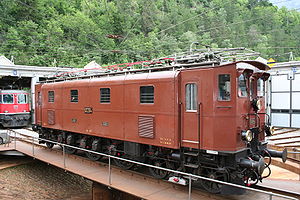SBB Ae 3/6 III
| SBB Ae 3/6 III | |
|---|---|
|
SBB Ae 3/6 III
|
|
| Numbering: | 10261-10271 |
| Number: | 11 |
| Manufacturer: | SLM Winterthur, SAAS Genève |
| Year of construction (s): | 1925 and 1926 |
| Retirement: | 1970-1980 |
| Axis formula : | 2'Co1 ' |
| Length over buffers: | 13,760 mm |
| Height: | 3780 mm |
| Service mass: | 89 t |
| Top speed: | 90 km / h |
| Hourly output : | 1,365 kW (1,800 hp ) |
| Continuous output : | 1,200 kW (1,560 hp) |
| Starting tractive effort: | 137 kN |
| Number of traction motors: | 6, 3 twin motors |
| Drive: | Westinghouse spring drive |
The SBB Ae 3/6 III is a standard gauge , single frame , universal locomotive with a single axle drive for alternating current of 15,000 volts 16 2 ⁄ 3 Hertz. It was ordered in 1925 and 1926 for the then newly electrified railway lines of the Swiss Federal Railways (SBB) in the lowlands and put into operation in a brown color. Most of the 11 machines delivered were in use until the 1970s, most recently in green. The Ae 3/6 III are basically largely identical replicas of the previously built Ae 3/5. As a result of a problematic driving behavior of the previously manufactured Ae 3/5 locomotive with the 1'Co1 'wheel arrangement at high speeds, the production of this locomotive was stopped after several construction lots and a further construction lot analogously to the Ae 3/6 I and Ae 3/6 II with the Axle arrangement 2'Co1 'ordered. The single-frame Ae 3/5 , together with the bogie locomotives Be 4/7 built from 1921 and the single-frame Ae 3/6 III built from 1925 , all with the Westinghouse spring drive, serve as a model for the Bernese Alpine Railway Company from 1926 Bern – Lötschberg – Simplon (BLS) delivered bogie locomotives Be 6/8 , the later Ae 6/8, which at that time was considered the most powerful electric locomotive in the world for several years.
prehistory
At the beginning of the electrification of the SBB in 1920 , locomotives were put out to tender, which were required to have three driving axles , an output of around 2000 hp and a top speed of 90 km / h. Three Swiss electrical companies each responded with their own design, the mechanical part of which always came from the Swiss Locomotive and Machine Works (SLM): Brown, Boveri & Cie (BBC) with the Ae 3/6 I , and the machine works Oerlikon (MFO) as well the Ae 3/6 II and the Société Anonyme des Ateliers de Sécheron (SAAS) with the Ae 3/5 .
Although the Ae 3/5 was built in four lots from 1922 to 1925, it did not have good cornering, which was due to the fact that the locomotive was extremely short. To remedy this, two weeks after the last Ae 3/5 an extended version was delivered on a trial basis, which - like the BBC and MFO machines - had a running bogie and was given the designation Ae 3/6 III . Instead of reordering further Ae 3/5, another ten Ae 3/6 III were procured.
construction
The locomotive largely corresponds to the Ae 3/5 express locomotives that were previously delivered . The mechanical part comes from the Schweizerische Lokomotiv- und Maschinenfabrik (SLM) in Winterthur , the electrical equipment from SAAS.
mechanical construction
The power transmission takes place in the same way as the Ae 3/5 via a Westinghouse spring drive . Unlike the previous locomotive, the Ae 3/6 III has only one Bissel axle at one end of the locomotive, and a bogie on the other side. It was hoped that this elongated construction would provide better guidance in the tracks.
Electric Construction
The series also corresponds to the Ae 3/5 electrically; it has a main oil switch , the transformer is located in the middle of the locomotive. The voltage of the traction motors is controlled via electropneumatic individual switches ( hops ).
The machines were neither equipped with multiple controls nor with an electric brake .
Operational use
Scrapping
The 10261 was the first locomotive to be scrapped in November 1968 after an accident. Between 1970 and 1972 a further locomotive was scrapped, three followed in 1976, as well as one each in 1977 and 1979. The last engine was scrapped in 1980 .
Locomotive 10264 has been preserved as an operational historic vehicle in brown in the Lausanne depot and belongs to the SBB Historic Heritage Foundation (SBB Historic).
These locomotives - together with the "small Sécherons" - mainly provided regional train services in western Switzerland in the 1960s and 1970s. At that time they were assigned to the Bern depot.
See also
Web links
- Ae 3/6 III 10264.SBB historic, accessed on November 8, 2010 .
- Pictures of the Ae 3/6 III in the digital railway photo archive
Individual evidence
- ↑ Where is the plain? , a radio broadcast by Swiss Radio and Television (SRF) from Sunday, March 4, 2012, 9:15 a.m., accessed on December 12, 2019
